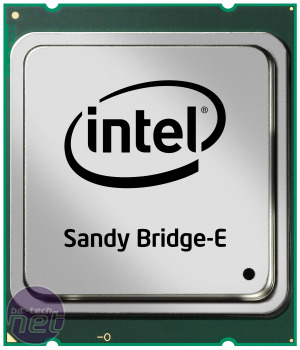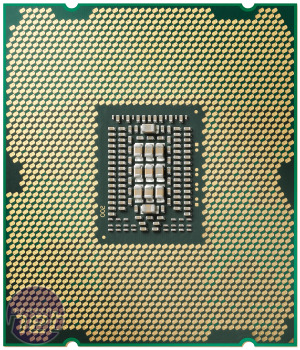Intel Core i7-3960X Extreme Edition Review
Manufacturer: IntelUK price (as reviewed): £839 inc VAT
US price (as reviewed): $1,050 (ex tax)
With six cores (and 12 threads) operating between 3.3GHz and 3.9GHz and a massive 15MB of Level 3 cache the i7-3960X should be stupidly fast. And it is, some of the time.
The trouble is that most consumer applications and games don't take advantage of 12 execution units. The end result is that beyond a certain execution unit count (typically six at most), consumer-level applications respond more to IPC and frequency. As the Sandy Bridge E CPU core design is essentially the same as the Sandy Bridge design, the performance of a Sandy Bridge E processor is similar to that of a Sandy Bridge CPU in lightly threaded applications.
Consumer application performance
The i7-3960X isn't in as bad a state as the laughably slow AMD FX-8150, as the underlying Sandy Bridge architecture has very high IPC. However, because it only operates between 3.3GHz and 3.9GHz it's barely faster than its quad-core LGA1155 Sandy Bridge stablemates in most consumer applications and games.For example, in our image editing test, the i7-3960X mustered a score of 1,805 - the fastest we've ever seen, but only 5 per cent more than the i7-2600K, a chip that costs nearly £600 less. What's more, the i7-2600K actually snuck ahead of the i7-3960X in our multi-tasking test, with a score of 1,727 versus 1,645.
However, those two extra cores did show a benefit in our video encoding test, with the i7-3960X streaking ahead of all the other CPUs, with an epic score of 3,985. In contrast, the previously awesome six-core (12-thread) Core i7-990X was 20 per cent slower as it's based on the Gulftown architecture.
Gaming performance
Our two test games ran a little faster on the i7-3960X. In Arma II: Operation Arrowhead for example the i7-3960X mustered a minimum frame rate of 96fps, while the i7-2600K managed 92fps. Meanwhile, the i7-3960X processed Shogun 2: Total War at 23fps while the i7-2600K managed 18fps. Given that these games address around six threads, the performance advantage over the i7-2600K is more likely due to the 15MB of Level 3 cache than the extra two cores of the i7-3960X.Professional application performance
The i7-3960X scored 11.29 in Cinebench R11.5, a good 22 per cent faster than the next fastest CPU, the i7-990X.Because the i7-3960X had proven so fast in Cinebench, we decided to add several dual-processor workstation systems into the mix. Impressively, despite having half the number of cores than the dual-processor Xeon systems and a quarter that of the dual-processor Opteron system, the single i7-3960X sped past the latter in all four tests. Clearly, AMD not only needs a new more competitive desktop CPU, it also needs a faster Opteron too.
The i7-3960X also compared favourable with the dual-processor Xeon X5680 rig, rendering faster in Terragen 2, but taking 17 per cent more time to render in LightWave 9.6. The single i7-3960X also kept up reasonably well with the pair of Xeon X5680s in the far more computationally complex Euler3D and FlamMap tests, slipping behind by only 22 per cent and 35 per cent respectively.
Overclocking
One of the big selling points of previous Extreme Edition CPUs has been overclocking, as typically they overclocked further than standard models. Unfortunately, despite the belt-and-braces 'X' and Extreme Edition branding (and associated astronomical price tag) the i7-3960X didn't prove to be the awesome overclocker we had hoped, as we could only overclock it stably from 3.3 to 4.7GHz. See the Test Setup page for details of all out overclocks.This is disappointing as most i5-2500Ks and i7-2600Ks overclock to 5GHz; furthermore, the i7-3960X required a bit more voltage (1.4V rather than 1.35V) but ran a lot hotter. It's not just the CPU that runs hot when overclocked though - the i7-3960X consumed so much power when overclocked that the tiny VRM circuits compressed in between the two banks of DIMMs also got extremely hot. We had to use a lot of cooling to keep the CPU and its VRMs at a reasonable temperature.
Our 4.7GHz overclock was achieved by setting the CPU multiplier to 38x, the Base Clock to 123.75MHz, the CPU strap to 125MHz and the memory to 1.98GHz. We'll explain more about overclocking Sandy Bridge E in a separate article to be published in the next few days.
Once overclocked, the i7-3960X continued to dominate most of the professional application performance charts. If you run a lot of heavily multi-threaded applications then a Sandy Bridge E system is worth considering: 6 cores (and 12 threads) of high-IPC performance makes sense. However, because most games and consumer applications do not make full use of the i7-3960X's twelve execution units and it overclocks less well than its quad-core sibblings, it's barely any faster.
Power efficiency
The i7-3960X guzzles power when sitting idle, drawing 179W from the wall, 61W more than the i7-2600K. It also draws a lot more power when working, with 289W drawn from the wall rather than just 180W for the i7-2600K.The real horror story is the power consumption of the i7-3960X when overclocked. Because it needs more voltage when overclocked than its quad-core sibblings, and because it's a bigger die, the i7-3960X drew an horrendous 538W under load. In comparison, the i7-2600K drew a far more demure 311W when overclocked.
Conclusion
The Intel Extreme Edition family has had a very chequered history. Some models, such as the Core i7-980X Extreme Edition, were very desirable because of the extra speed and overclockability. Other Extreme Editions were less attractive, as they weren't much faster than standard chips, weren't great overclockers and so couldn't justify their huge price premium.The i7-3960X very much falls into the second category, simply because most consumer applications and games do not make full use of its six Hyper-Threaded cores. You're being asked to pay a huge price premium for a significant part of the CPU to be sitting idle most of the time, and so we simply cannot recommend buying one for a gaming or consumer-level PC.
We initially thought that the i7-3960X might prove an excellent alternative to a dual-processor system for those running professional applications. This is because most workstation/server applications are n-threaded. However, the i7-3960X isn't the only 6-core, 12-thread CPU that Intel is launching today. The i7-3960X is also joined by the Core i7-3930K, which delivers very similar performance at a significantly lower price. This makes more sense for a low-fi workstation.
Intel Core i7-3960X Extreme Edition Specifications
- Frequency 3.3GHz
- Turbo Boost Frequency up to 3.9GHz
- Core Sandy Bridge E
- Manufacturing process 32nm
- Number of cores six physical, six logical
- Memory controller Quad-channel DDR3
- Cache L1: 32KB + 32KB (each core), L2: 256KB (each core), L3: 15MB (shared)
- Packaging LGA2011
- Thermal Design Power (TDP 130W
- Features SSE, SSE2, SSE3, SSSE3, SSE4, SSE4.2, EM64T, EIST, Execute Disable Bit, VT, AES-NI, Turbo Boost 2.0, AVX


MSI MPG Velox 100R Chassis Review
October 14 2021 | 15:04











Want to comment? Please log in.